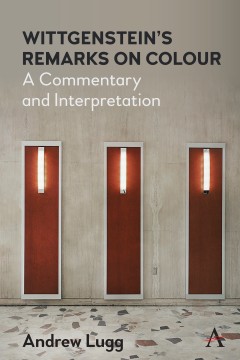Wittgenstein’s Remarks on Colour
A Commentary and Interpretation
By Andrew Lugg
Other Formats Available:
- About This Book
- Reviews
- Author Information
- Series
- Table of Contents
- Links
- Podcasts
About This Book
Wittgenstein’s remarks on colour have been accorded little critical examination, the sole exception being the explanation in the Tractatus of the logical impossibility of a point in the visual field having two colours simultaneously, a gap the present work is primarily meant to fill. Remarks on Colour, a compilation of writings on the subject drafted in the last fifteen months of Wittgenstein’s life, is subjected to sustained critical scrutiny and is shown that it does not deserve to languish in the limbo to which it has been mostly consigned, but it indeed is deeper and more illuminating than other more studied writings, to say nothing of peripheral writings on ethics, aesthetics and religion.
The Remarks would warrant a careful look if only because it is, as it has been billed, ‘one of the few documents which shows [Wittgenstein] concentratedly at work on a single philosophical issue’. But it also deserves special consideration and is worth grappling with since it shows Wittgenstein thinking through a problem from scratch and, what is still less common, without knowing where he will end up. In particular no other extended stretch of writing so clearly shows him as engaged in an unconstrained investigation of a topic of huge general interest and setting the agenda for philosophers, indeed as pioneering a still insufficiently investigated subject. And following in his footsteps pays since it brings to light a great deal about how he approaches philosophy and proves to be a good way into the philosophy.
Wittgenstein’s once said: ‘Sometimes a sentence can be understood only if it is read at the right tempo’, and the present work takes him at his word and accords him the courtesy of treating his own sentences as ‘all to be read slowly’. His remarks are examined one by one in the order he wrote them rather than the order they appear in the published text with close attention to his toing-and-froing and changes of tack. The result is a picture of a serious philosopher at work, one grappling with rare scrupulousness to a series of problems. Just as importantly one sees that the thrust of his deliberations is routinely misidentified, that there are significant similarities as well as significant differences between his late and early thinking about colour, and that much folklore, both laudatory and disparaging, that has sprung up regarding the thinness of his reasoning and the thickness of his conclusions is substantially off-base.
Reviews
‘In this astonishing work of scholarship, Andrew Lugg elucidates and interprets a neglected late work of Wittgenstein’s. Not a summary but an unfolding that sheds light on the text line by line while clearing away the debris of misunderstandings. Wittgenstein emerges as his students, friends and contemporaries knew him, a powerful figure riveted by philosophical questions.’ — Béla Szabados, University of Regina, Canada
‘The book is a significant contribution to the philosophy of colour. In the first detailed account of the origins, organization and arguments of Wittgenstein’s Remarks on Colour, Lugg discusses all remarks and argues that, in Wittgenstein’s view, colour concepts display logical necessities and logical impossibilities.’—Mauro L. Engelmann, The Federal University of Minas Gerais (UFMG), Brazil
‘Lugg's new work is much welcome for scholars and non-scholars interested in Wittgenstein's work in general and in his intriguing and intricate remarks on colors, in particular. I do not know any other material which investigates Wittgenstein's important critical reactions to Goethe's Farbenlehre with such detailed examination. A treatment of what Wittgenstein says remark by remark is a great contribution for all students of philosophy interested in metaphysics, epistemology and aesthetics of colors. Lugg's new book will become a vital reference in virtually any work on Wittgenstein's philosophical development.’ —Marcos Silva, Federal University of Pernambuco, Brazil.
‘This superbly researched and fascinating study of Wittgenstein’s widely neglected Remarks on Colour fills a major gap in Wittgenstein scholarship. Combining meticulous analysis of the text with a deep appreciation of Wittgenstein’s conception of philosophy, it will be welcomed by philosophers, artists, and anyone else with an interest in colour.’ — Dr Mario von der Ruhr, Swansea University, UK
‘As Lugg notes in his extremely helpful new book, Wittgenstein observes that his “sentences are all to be read slowly”. Lugg takes Wittenstein at his word and discusses the often enigmatic remarks collected in his posthumous Remarks on Colour one by one. In this brilliantly lucid study of Wittgenstein’s late reflections on colour Lugg does his readers a great service by taking these ideas seriously as contributions to an illuminating examination of what, following Wittgenstein, may be called the “logic” of our colour terms.’ — Joachim Schulte, University of Zurich, Switzerland
‘Andrew Lugg’s book is at once an exceedingly close reading and a far-reaching provocation. This careful, deep dive into Remarks on Colour yields a detailed analysis of Wittgenstein’s approach to philosophical questions about colour, while also making a case for Lugg’s own distinctive reflections on Wittgenstein’s work, early to late. — Naomi Scheman, University of Minnesota, US
Author Information
Author of Wittgenstein's Investigations 1-133, Andrew Lugg writes on the philosophies of Ludwig Wittgenstein and W.V. Quine. He lives and works in Montreal.
Series
Anthem Studies in Wittgenstein
Table of Contents
Preface; Acknowledgements; Chapter One Wittgenstein on Colour, 1916–1949; Chapter Two Remarks on Colour, Part II; Chapter Three Remarks on Colour, III.1–42; Chapter Four Remarks on Colour, III.43–95; Chapter Five Remarks on Colour, III.96–130; Chapter Six Remarks on Colour, III.131–171; Chapter Seven Remarks on Colour, III.172–229; Chapter Eight Remarks on Colour, III.230–350; Chapter Nine Remarks on Colour, Part I; Chapter Ten Learning from Wittgenstein; Bibliography; Index.
Links
Stay Updated
Information
Latest Tweets



